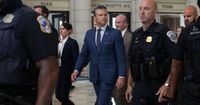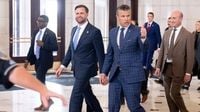On August 20, 2025, the marble halls of Washington, D.C.’s Union Station echoed with more than just the usual bustle of commuters. Instead, the city’s grand transit hub became a stage for a political drama—one that pitted top Trump administration officials against a chorus of angry local residents and protesters. Vice President JD Vance, Defense Secretary Pete Hegseth, and White House deputy chief of staff Stephen Miller arrived for what was supposed to be a morale-boosting photo op with National Guard troops deployed across the capital as part of President Donald Trump’s controversial federal crackdown on crime.
The plan seemed simple enough: buy lunch for the troops at Shake Shack, shake some hands, and pose for the cameras. But almost as soon as the trio entered the station, they were met with a wall of sound—protesters chanting “Free D.C.!” and jeering so loudly that it drowned out much of what the officials tried to say. According to ABC News, the heckling was relentless, with protesters following the group both outside and inside the restaurant, their chants echoing off the high ceilings and making it nearly impossible for Vance, Hegseth, and Miller to get their message across to the assembled press.
“Well, a lot has changed in the past seven days,” Vance told the assembled National Guard troops, referencing the recent federal surge against crime in D.C. “You guys are doing a hell of a job. I’m proud of you and we’re grateful.” But as he spoke, the chants of “Free D.C.” and other, more personal insults—some unprintable—filled the air. The scene, captured in videos shared widely on social media, showed a clear disconnect between the administration’s message and the mood of many D.C. residents.
Stephen Miller, never one to shy away from controversy, dismissed the protesters as “elderly white hippies” and “stupid white hippies,” according to reporting from The Independent and New York Magazine. “They’re not part of this city and never have been,” Miller insisted, suggesting that the demonstrators were outsiders whose views did not reflect those of most D.C. residents. Miller went a step further, claiming, “Most of the citizens who live in Washington, D.C., are Black. This is not a city that has had any safety for its Black citizens for generations, and President Trump is the one who is fixing that, with the support of the Metropolitan Police Department, the support of the National Guard, and our federal law-enforcement officers.”
But poll numbers tell a different story. The Washington Post and Schar School conducted a survey of 604 adult D.C. residents from August 14 to August 17, just days before the officials’ visit. The results were stark: 79 percent of city residents opposed Trump’s federal takeover, with 69 percent saying they did so “strongly.” When asked if they thought the deployment of the National Guard and federalization of the police would help decrease violent crime, 65 percent said no. In fact, 61 percent reported that the increased presence of federal law enforcement made them feel less safe, while only 18 percent said it made them feel more secure.
Vice President Vance, for his part, was skeptical of such polling. When pressed by a reporter about the widespread local opposition, Vance replied, “I’m highly skeptical that a majority of D.C. residents don’t want their city to be—to have better public safety and more reasonable safety standards within Washington, D.C. I don’t know what poll you’re talking about, maybe the same poll that said that Kamala Harris would win the popular vote by 10 points.”
Vance also pushed back against the idea that the National Guard’s presence was unnecessary, arguing that Union Station had become overrun by “homeless people,” “drug addicts,” “vagrants,” and the “chronically homeless,” making visitors feel unsafe. “This should be a monument to American greatness,” he said, lamenting what he saw as a decline in public order. He further claimed that “crime statistics do not report the full scope of crime on the streets of the nation’s capital,” and that “statistics from the Department of Justice and the FBI back it up.”
Yet, D.C. Mayor Muriel Bowser offered a different perspective. At a back-to-school event the same day, Bowser said, “Crime has gone down in our city and it has gone down precipitously over the last two years because of a lot of hard work, changes to our public safety ecosystem, including changes to the law. And we know that those facts don’t comport to what some people are saying, but those are the facts.” Bowser also made clear her opposition to the use of National Guard troops for law enforcement, stating, “They have to be used on mission specific items that benefit the nation.”
Metropolitan Police Department Chief Pamela Smith struck a slightly more conciliatory tone, acknowledging that the presence of federal agents had been “helpful to some officers and community members.” “Hearing from the officers on the street, some of them have found it to be very helpful, some people in the community have found it to be very helpful,” Smith said, according to ABC News. She also emphasized the collaborative relationship between local police and federal agencies, even as the overall public response remained deeply divided.
As the visit continued, the officials’ attempts to tout the success of the federal crackdown were repeatedly drowned out by the crowd’s chants. Vance claimed that, since the National Guard’s arrival, there had been a 35 percent reduction in violent crime and a 50 percent drop in robberies over the past nine days, though the origin of these statistics was unclear and not independently verified by media outlets. Meanwhile, National Guard troops were seen not just in high-crime neighborhoods, but also patrolling tourist-heavy areas like the National Mall and major Metro stations—raising questions about the deployment’s true focus.
The tension extended beyond Union Station. In neighborhoods like Columbia Heights, crowds confronted law enforcement officers, some wearing Homeland Security Investigations uniforms, chanting, “ICE, go home!” The Justice Department had recently directed local police to support federal immigration enforcement actions, a move that clashed with D.C. laws limiting cooperation with immigration agencies. Last week, protesters gathered at a vehicle checkpoint run by HSI agents and D.C. police, shouting, “Go home, fascists!”—a further sign of the city’s resistance to the federal presence.
Throughout the ordeal, Vance and Miller repeatedly dismissed the demonstrators as “crazy” and “communists,” with Vance telling Fox News later that day, “You hear these guys outside. They appear to hate the idea that Americans can enjoy their communities.” Miller insisted, without evidence, that the protesters were not representative of the city, echoing a refrain heard often throughout the Trump administration’s tenure.
Despite the administration’s efforts to project strength and resolve, the day’s events at Union Station laid bare the deep divisions between federal authorities and the residents of the nation’s capital. The jeers, chants, and poll numbers all pointed to a city that, far from welcoming the National Guard, felt increasingly alienated by the federal crackdown. As the officials departed amid a cacophony of boos, the question lingered: whose city is Washington, D.C.—and who gets to decide its future?
For now, the city’s answer seems loud and clear, reverberating through Union Station and beyond.



